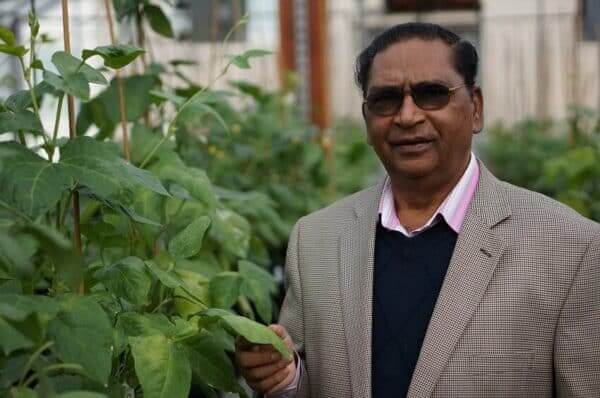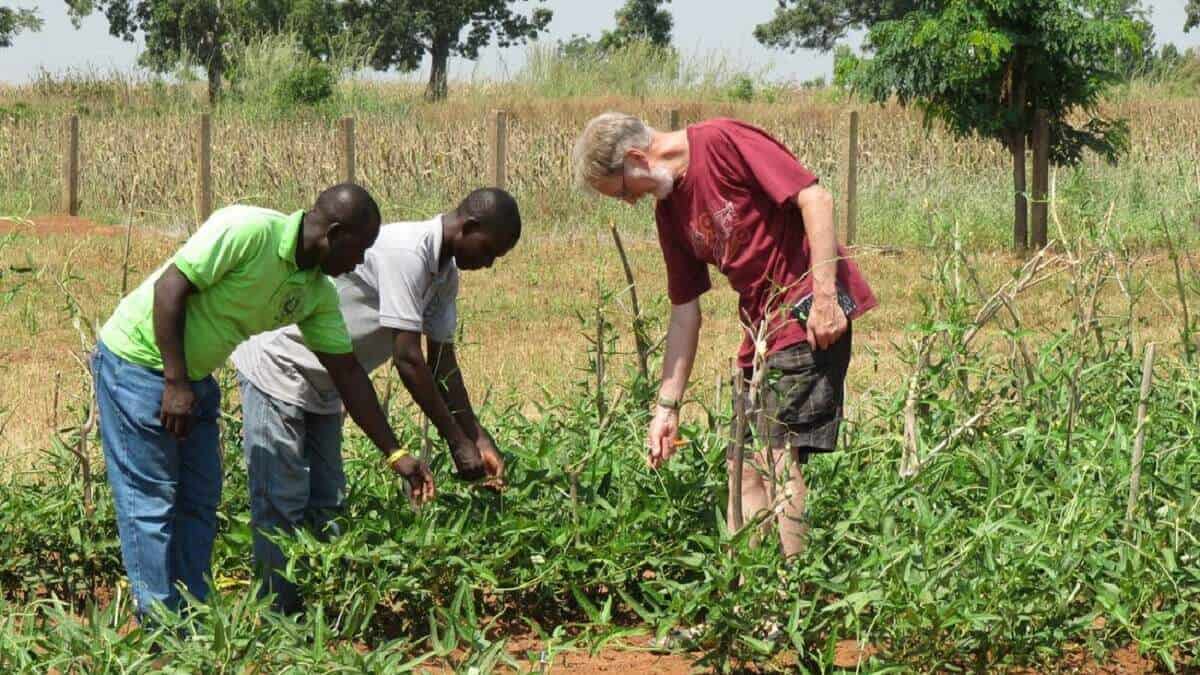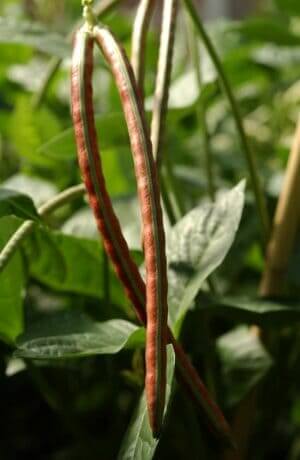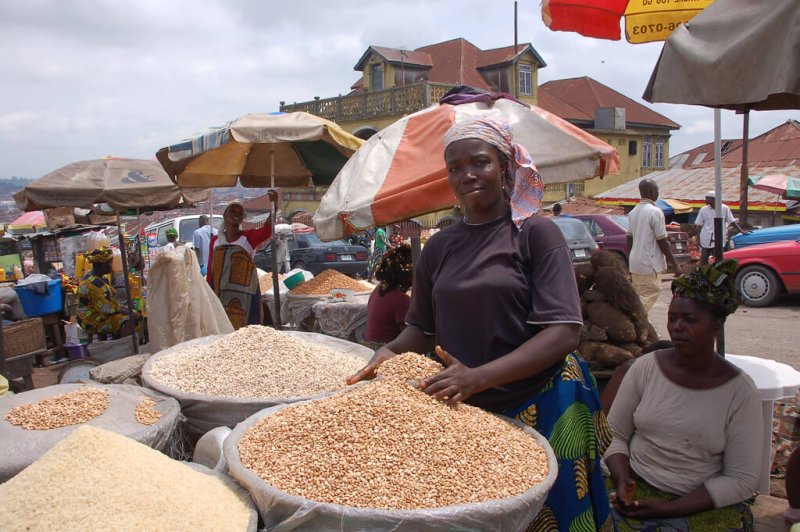Not a lot has improved for Nigeria’s subsistence farmers over the years. Most can’t afford fertilizer and chemicals; there’s no irrigation or power. Life has only gotten tougher because of climate change and internal conflicts. Nigeria also has a massive poverty problem – more than 91 million Nigerians are estimated to live without enough food to eat. Add to that a fast-growing population set to double by 2050.
But this July, Nigerian farmers had cause for cautious optimism. A new variety of the country’s staple legume, genetically modified (GM) cowpea—also known as black eyed peas—was finally planted after years of delay and debate. It promises to bolster food security and the incomes of small farmers.
“The demand is outstripping supply,” said Mohammad Ishiyaku, a geneticist and cowpea breeder at Ahmadu Bello University in northern Nigeria.

Cowpeas are a staple crop and an important source of protein for over 200 million people. While Nigeria is the world’s largest producer of cowpea, it still has to import around 500,000 tons annually to meet internal demand. This is because insects ravage up to 90% of the crop, most of it in the field and about a quarter of it in storage.
By controlling the major field pest—the cowpea pod-borer – the introduction of the GM cowpea could cut imports by half, said plant pathologist Issoufou Abdourhamane, the cowpea project manager for the African Agricultural Technology Foundation (AATF).
“The development and release of the [GM] cowpea in the country is by no means a small feat in the country’s quest to attain food and nutritional security”, added AATF Executive Director, Canisius Kanangire.
Desperation breeds innovation
This new variety has taken 40 years to develop—20 years to improve its traits through traditional breeding and another 20 years using genetic engineering to shield the cowpea against enemy number one, the Maruca pod borer moth. Ishiyaku said farmers have been impressed by what they’ve seen in field trials: fast-maturing varieties that deliver a harvest before the rains fail, combined with resistance to the dreaded Maruca.
The army of African and international devotees who’ve devoted their careers to the improvement of cowpea have high hopes. The crop should give the families of subsistence farmers—70% of the population—a leg up out of poverty. By lowering their spending on pesticides and raising yields, Ishiyaku believes the crop could enhance farmers’ income by close to 30%.
In adopting the GM cowpea, Nigeria has bucked the trend of powerful campaigns that have blocked GM crops from being approved in most African and Asian countries. While Nigerian farmers are now free to plant the GM cowpea, anti-GM activists in neighboring Ghana, supported by European anti-GM groups, have filed a court injunction to block approval.
For now, Nigeria leads the pack among the countries in Africa when it comes to being guided by science.
“It’s the one place advanced biotechnology is not going backwards,” said Robert Paarlberg, a political scientist at the Harvard Kennedy School for Government and author of “Resetting the Table: Straight Talk about the Food We Grow and Eat”.
Poor man’s meat
For Nigeria’s subsistence farmers, what they grow is what they put on the table. And when their crops fail, their families starve. Out in the savannah, families live in hamlets dotted with mudbrick roundhouses topped by conical thatched roofs. In the surrounding fields on half-acre lots, each farmer grows sorghum, millet, cassava, yams, plantain and most important of all, the cowpea.
Cowpeas are a staple food and an important source of protein, mostly grown in West Africa. “Poor man’s meat” provides the major source of protein, as it has since time immemorial. Most families would consume cowpeas daily either boiled and eaten with rice or fermented and cooked in oil to provide a tasty local dish known as akara. The leaves also provide greens for the family meal while the stalks are a highly nutritious fodder for livestock. If there’s a bumper harvest, the cowpea also brings in some extra cash at the local market.
Cowpea is a hardy legume, well adapted to the dry conditions and poor soils of the tropical savannah. But while it has been handed down the generations from farmer to farmer, it had not benefitted from modern breeding programs that so dramatically improved the yield of wheat, rice, corn, and soybeans. Worse there was no way to control the predations of Maruca, the diminutive brown and white moth whose caterpillars routinely devour 20% to 80% of the crop. For four decades, improving the yield of cowpea has been the holy grail for Nigeria’s plant breeders.
Their quest began in 1979 at the International Institute of Tropical Agriculture (IITA) in Ibadan, some 500 km southwest of Nigeria’s capital, Abuja. Plant breeder B.B. Singh had just arrived. He was known as “Mr. Soybean” for breeding high-yielding soybean varieties in the US and then introducing them to India. Now “Mr. Soybean” was set to become “Mr. Cowpea.”

Singh’s approach was like that of a racehorse breeder, casting his eye over 15,000 types of cowpea from around the world, plying his art to mix and match the desired traits. When he began, farmed varieties of cowpea sprawled along the ground using up precious space and took five months to ripen their pods. Sixteen years later his “racehorse” variety grew upright, so each seedling required less space and more could be packed into the farmer’s field. Their time to ripen was shortened to two months, safeguarding a harvest if seasonal rains failed – an increasingly common occurrence. And to top it off, he bred in resistance to thrip, aphids, bruchids and striga—a pretty pink parasitic weed.
Singh’s 16-year effort increased the yield of cowpea from 0.2 tons per hectare to over 2 tons per hectare in the greenhouse. But out in the fields, it was a different story. Those gains could be obliterated by one little brown and white moth.
“That’s when I started shouting [Maruca] pod-borer,” Singh told me. Unfortunately, Singh’s stud book of cowpeas did not include an entry for Maruca resistance.
For the few farmers who could afford it, the only way to control Maruca was spraying with pesticides up to eight times over the growing period. Quite beyond what most Nigerians, who live on $1.50 per day, could afford. It was also dangerous for farmers who were not familiar with pesticides and lacked protective gear, particularly since pesticides considered harmful and prohibited in other countries are still widely sold. There are anecdotes of pesticide formulations being brought home in tempting Coke bottles and of people dying after eating perfect-looking soybeans.
Singh knew of a solution, the same one that had worked for soybeans. But it could not be achieved with conventional plant breeding because the necessary gene came from the soil bacterium, Bacillus thuringiensis (Bt). Caterpillars die after ingesting these soil bacteria because a bacterial protein bores a hole into their gut. It’s bad for the caterpillar but excellent for biodiversity since bees and other types of insects are unaffected.
Organic farmers around the world grow buckets of Bt and spray it on their crops. African farmers tried it too, but the bacterial sprays lasted only a few days and had little effect on the caterpillars burrowed away inside the pods. A more effective and economical approach is to protect plants with an inbuilt version of the bacterium’s gut-boring gene through genetic engineering.
Secret weapon Higgins
In the 1980s, genetic engineering succeeded in introducing the bacterial gene, commonly referred to as Bt, into commercially grown soybeans, corn and cotton. Singh’s comrade-in-arms in the Maruca wars was Purdue University entomologist Larry Murdock. He had tried for years to introduce foreign genes into the cowpea without success. But Murdock knew a scientist from Australia’s national research agency, CSIRO, who might succeed.
He turned to Thomas Joseph Higgins, an Australian scientist and plant breeder. “Higgins was my secret weapon,” Murdock told me. Murdock arranged a conference in Senegal in 2001 and invited him. Higgins’ reputation for coaxing new genes into legumes was already legendary. TJ, as he is generally known, fits the stereotype of what you might expect of a plant breeder. White-bearded and bespectacled, he speaks with a soft Irish lilt and there’s an air of unflappable calm about him.

Higgins was flattered to be invited to the Senegal conference as the keynote speaker, though he had no inkling why he’d been so honored. He described his success using genetic engineering to improve legumes for the benefit of sheep. For instance, he had succeeded in making lupins more nutritious by giving them an albumin gene from the sunflower. He had also protected field peas from the predation of beetle grubs by giving the peas a protective gene from beans.
Higgins described all these feats to his audience. They appeared singularly unimpressed. As he recalls, the general sentiment was something like: “All very well you doing this for sheep but surely you can use this technology to do something for hungry Africans.”
The request did not fall on deaf ears. Touring the farming hamlets of the Nigerian countryside was a familiar experience to him. “This is how I grew up,” he tells me. Higgins’ parents were poor Irish farmers who expended their energies growing enough food to feed the family of six. Had their first child not won a scholarship, there would have been no funds for his secondary education.
Higgins had no illusions as to the difficulty of the task requested of him. Introducing so-called foreign genes (meaning they are from another species) into plants was more of an art than a science at this stage in the agricultural biotech revolution. It relied on hijacking the operations of yet another soil bacterium, Agrobacterium tumefaciens. This bacterium induces tumors around the roots of the plants it infects, often visible as gnarly growths at the base of roses or fruit trees. It does this by sneaking its own genes into the DNA of plant cells to turn them into factories for producing its preferred nutrients.
But while Agrobacterium readily infects roses and fruit trees, it shows little inclination for grains and legumes. To infect them requires tissue culture. That means mincing plant tissue into clumps of cells, incubating them in a cocktail of Agrobacterium, plant hormones and nutrients, selecting out plant cells that had taken up the bacterial genes and then trying to generate a complete plant from those cells.
Every step of the procedure is “hit and miss”, and success is often hard to replicate. Large companies like the US agricultural and chemical company Monsanto (acquired by the German company Bayer in 2018) ultimately succeeded with soybeans, cotton, canola and corn; its huge investment was ultimately justified by the profits realized by producing a new generation of value-added crops. Higgins was one of the few public sector scientists to have succeeded with legumes on a modest budget.
There was no doubt the technological hurdle for engineering cowpeas would be high. Yet that was just the beginning. There was also an emerging extreme hostility to GM technology in Europe, views that were being exported to its former colonies in Africa.
Prying open the door to crop biotechnology
So, at the Senegal meeting when the cowpea breeders beseeched Higgins to genetically modify the cowpea, he knew it would be challenging. Not only would the technology trail have to be paved stone by stone, should he succeed the anti-GM lobbyists would be there at every point doing their best to derail him.
But the African pull was irresistible. “This was about food security,” said Higgins.

And so, the Network for the Genetic Improvement of Cowpea for Africa (NGICA)— the name the attendees of the Senegal meeting gave themselves—was born. And Higgins began paving his uphill path. At first it was a night-time affair. His day job was deputy head of CSIRO Plant Industry, whose goal was to develop solutions for Australian farmers. Though his bosses would allow CSIRO space and infrastructure to be allotted for the African cause, as far as funding manpower and materials, Higgins would need to find an additional source.
The Rockefeller Foundation and then USAID came through with grants. These allowed him to hire a slew of top scientists, including Juan Carlos Popelka from Germany and local tissue culture experts, Stephanie Gollasch, Lisa Molvig and Andy Moore.
Meanwhile the African Agricultural Technology Foundation (AATF) took the role of co-ordinating the many moving parts of the project, involving Nigeria’s Institute for Agricultural Research and Ahmadu Bello University and international players including CSIRO and the Donald Danforth Plant Science Center in the US. It was the AATF that also began negotiating with Monsanto, who owned the intellectual property for the use of the Bt genes. Monsanto agreed to a free license for the use of the Bt gene for the cowpea in Africa.
By 2006, Higgins’ CSIRO cowpea team had grown to five and they had their first success at coaxing the reluctant cowpea to accept new genes from Agrobacterium tumefaciens.
By 2009, Nigerian scientists were testing the plants in the field at Ahmadu Bello University in Northern Nigeria. Compared to non-GM plants, they were highly protected against Maruca.
In parallel, Higgins was navigating the regulatory hoops required by Nigeria’s National Biosafety Management Agency (NBMA) with help from the National Biotechnology Development Agency (NABDA).
Developing the GM crop would take a decade. Meeting the safety requirements would take even longer.
Read part 2 on September 29, 2021.
Elizabeth Finkel is a former biochemist and editor-at-large of Australian-based Cosmos magazine. Find Elizabeth on Twitter @ElizabethFinkel































